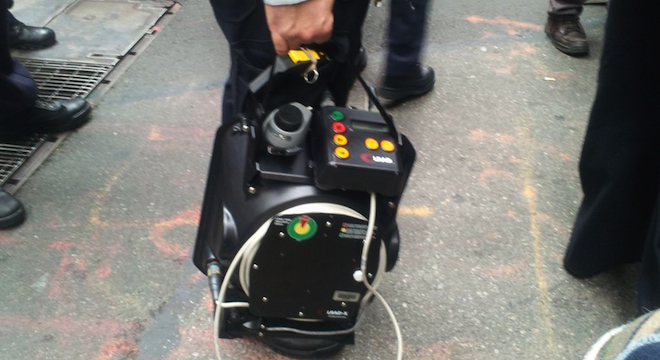Occupy Wall Street supporters have blasted the New York Police Department’s use of Long Range Acoustic Devices to respond to the civil disobedience actions that sprang up throughout Manhattan on Thursday.
“So it’s official: NYPD is using LRAD sound cannons. Usually used during combat, they send harmful, pain inducing tones over long distances,” tweeted the Occupied Wall Street Journal account.
“LRAD works according to the same principle as that old Memorex commercial. Your skull is the wine glass and the cops are Ella Fitzgerald,” tweeted Anon Street Medics.

Photos of an LRAD being carried around by an NYPD officer were snapped by Joshua Paul, an Android developer on the ground during Friday’s clashes.
But the LRAD Corporation, the San Diego-based company that manufacturers the devices (and there are at least six distinct products, ranging from the “handheld” LRAD 100X to various vehicle-mounted and stationary devices), asserts that its products aren’t weapons at all, not even less than-lethal ones, but rather that they are primarily “communication devices,” and superior ones at that to alternatives such as the trusty old megaphone, or bullhorn.
“The police are likely using it to communicate,” with the protesters, said Scott Stuckey, Vice President for Business Development at the LRAD Corporation, in a telephone interview with TPM. “Megaphones aren’t loud enough to reach people over a large, crowded space, with lots of background noise.”
Indeed, LRAD’s website advertises the products to law enforcement and military clients as being variants of a “high-intensity directional acoustic hailer designed for long-range communication and issuing powerful warning tones…”
The website continues:
LRAD can broadcast in any language with authoritative and highly intelligible communication. LRAD provides military personnel with a powerful, penetrating warning tone that can be followed by clear voice broadcasts in host nation languages to warn and shape the behavior of potential threats.
And although Stuckey acknowledged that the devices contain “loud tones,” meant to warn people in the path of the devices or drive them away from a specific area, he said that “if someone does find it too loud and they have two free hands they can cover their ears” to dampen the sound.
He equated it to “having a spotlight or really bright flashlight” shined in your eyes.
Occupy Wall Street protesters and supporters have been circulating LRAD-blocking strategies online, ranging from using a flat object to reflect the sound back at the devices and their operators, to buying Air Force-grade ear plugs.
Even in that case though, Stuckey says that his company’s products allow law enforcement to communicate clearly and effectively.
“They’ll still hear the message,” Stuckey added.
LRAD’s handheld device, the LRAD 100X, which was spotted in the hands of New York police officers on Thursday by protesters and press on the ground, produces 137 decibels at 1 meter. Human hearing is immediately damaged when exposed to 140 decibel noise, which also results in physical pain, according to How Stuff Works.
Stuckey told TPM that LRAD has “louder projects on the drawing board,” but wouldn’t advocate using them in this type of environment.
Still, Stuckey pointed out that the decibel level of the handheld LRAD his company sells is “not as loud as flash bang grenades” currently being used by many police departments around the world, including the police officers responding to the Occupy Oakland demonstrations on October 25, who detonated a flash bang after a crowd rushed to help a 24-year-old ex-Marine allegedly shot in the face by a police tear gas canister.
Stuckey also noted that LRAD technology directional — the sound is focused in a single beam, rather than radiating out in a circle as in the case of most other acoustic sources, including flash bang grenades.
“I will say, I think it is the most responsible police departments around the world that are using LRAD,” Stuckey said.
LRAD’s technology and order information is proprietary, but Stuckey said that the devices contain a driver that has been optimized to recognize and amplify the human voice, and signal processing to help pick-up specific syllables and vowels that sometimes drop out of human speech, especially when addressing a large, loud audience.
“We strive to make sure every syllable is heard,” Stuckey told TPM.
Stuckey also confirmed that “many” LRAD devices had been ordered by the government of Thailand to help with flood relief in that country. Stuckey said that LRAD devices are in use by government agencies and other companies around the globe for purposes well beyond crowd control, including bird and wildlife dispersal from airports and industry sites, missing persons cases, fighting wildfires, even on school campuses as emergency-preparedness equipment, to warn a campus in the case of a school shooter.
Stuckey did concede that none of LRAD’s clients were civilian in nature, noting that one of the company’s major successes occurred when Pittsburgh police used the device to disperse and control the crowds of protesters outside the G20 conference there in 2009. The LRAD website also proudly touts the NYPD’s use of LRAD during the 2004 Republican Convention and in Times Square on New Year’s Eve.
“We want the police to have it,” Stuckey said, “If we send the police out there with clubs and teargas and Tasers, and they don’t have the ability to communicate, all we’re going to do is upset both sides.”






